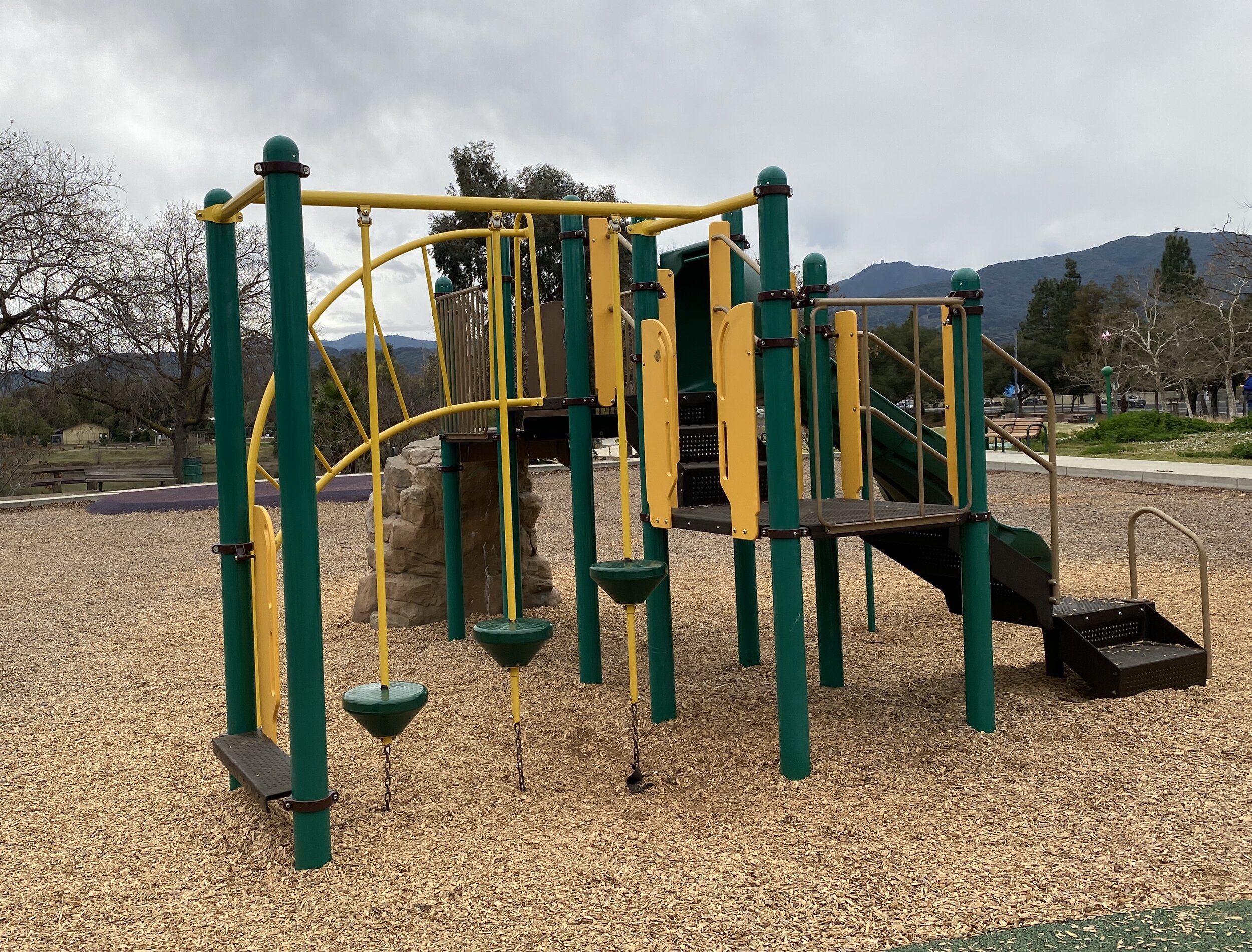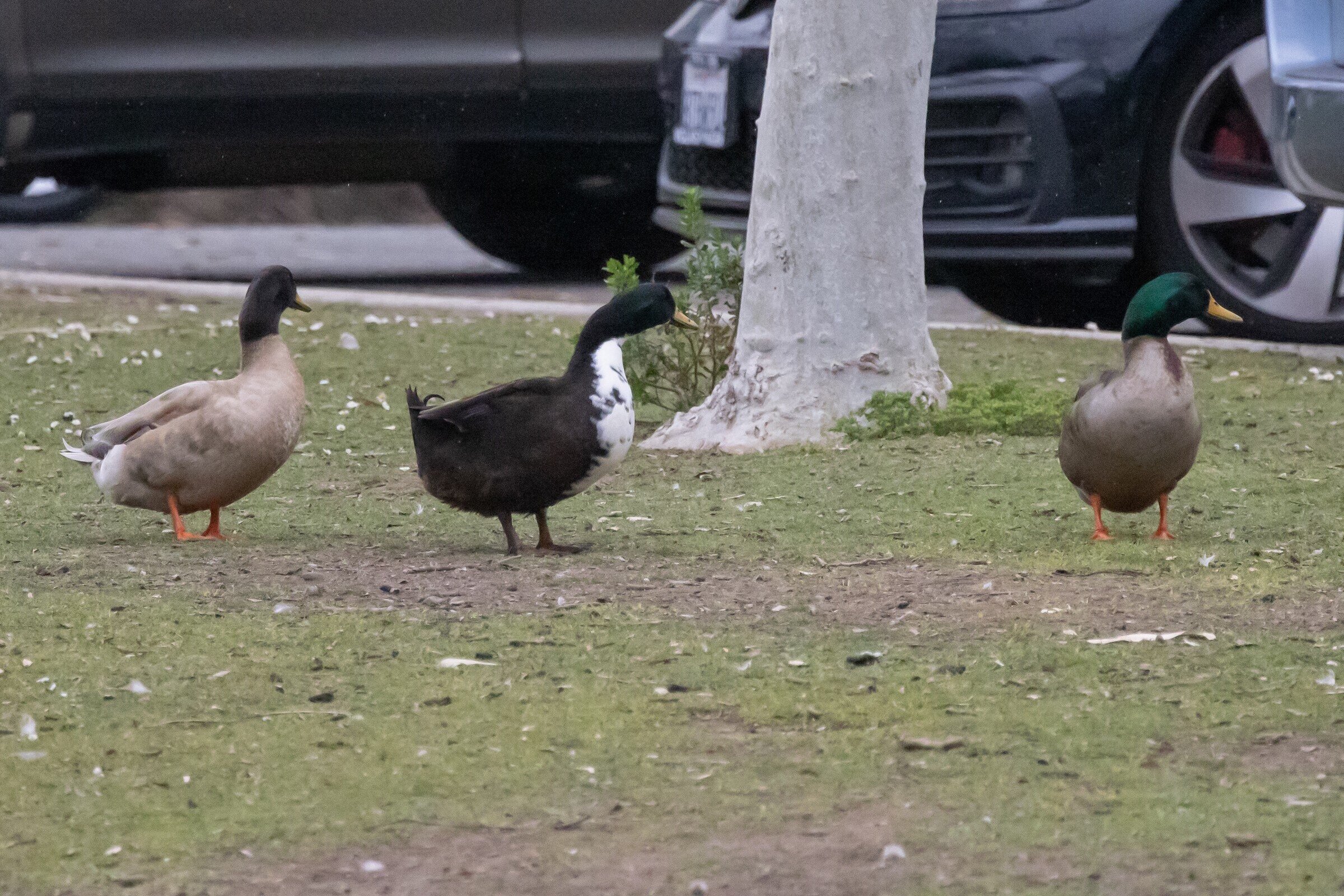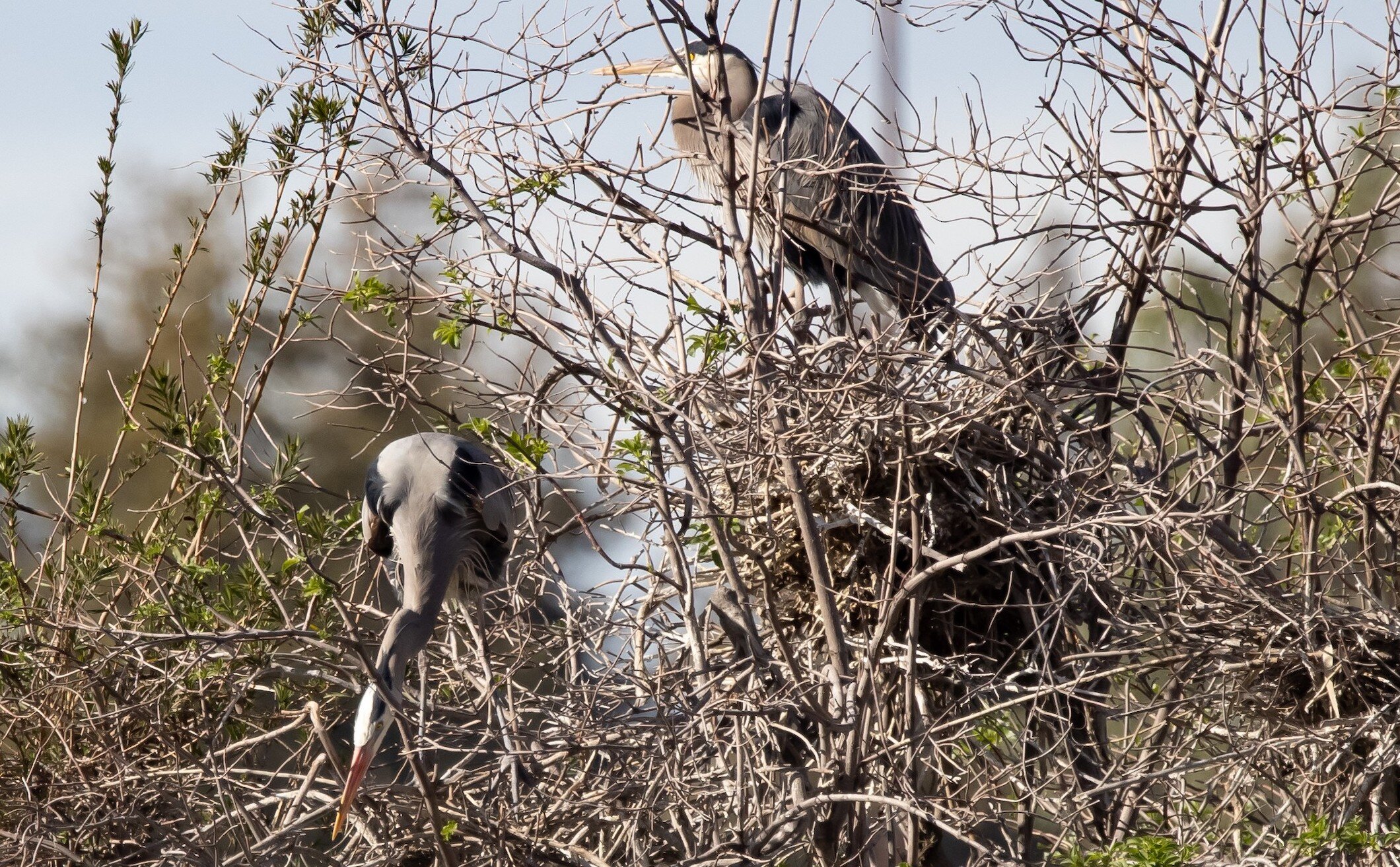Almaden Lake Park (Spring):
Nesting Birds and “What is a Species?”
BY GINGER LANGDON-LASSAGNE
San Jose’s Almaden Lake Park is centrally located in Almaden Valley, and readily accessible either by car or by public transit. It’s a great place to start off birding with kids of any age, but particularly useful for older elementary and middle school age kids, who are learning about the concept of individual variation within a single species of bird. One can see ducks and geese and there are also pied-billed grebes, mergansers, coots and cormorants in the lake. Herons have been seen creating nests and raising their young on the island. Many smaller birds are attracted to the riparian habitats of Los Alamitos Creek and the Guadalupe River that converge at this location. Look for the bluebird nest boxes!
This park is fun year-round, but early spring is particularly exciting for birding this park, because the heron nests on the bird sanctuary island put on quite a show! Ducklings and goslings also begin to hatch around mid-March, and early migrant birds such as swallows begin to return as early as late February.
A 1.2 mile path, broad and well-paved, circles the lake. It provides a stroller-friendly walk for even the smallest nature-loving kid. Trees provide good shade around much of the distance, and benches are frequent. There are three different playgrounds around the lake’s shore. A drawback to this park that parents of small children should be aware of: as with any park with many ducks and geese, the lawns can be a minefield of biological residue. 😐 Bring wet wipes for the bottoms of the shoes at the end of the day.
Trip Covers: March - May
Key Birds: Mallard and Mallard (domestic type), Common Merganser, Double-crested Cormorant, Great Blue Heron, Western Bluebird, Yellow-rumped Warbler
How To Bird
Almaden Lake has two parking areas: one on the Eastside on Winfield Boulevard, and the other on the Westside with access from northbound Almaden Expressway. Either parking area is a good starting point, and each has accessible, clean restrooms with soap and paper towels at the sink. This guide will begin at the Westside, at the playground areas there. To use this field trip from the Eastside, simply reverse the directions!
The trees adjacent to the parking areas and playground in the Westside have several nest boxes like the one shown in the photo below. These boxes are used by a variety of birds, most commonly Oak Titmice and Western Bluebirds, but also Violet-Green Swallows and House Sparrows. Sit quietly and watch from a distance, and see if you can spy some prospective nest-builders, checking out the best home sites, or tending to their nestlings.
Male Western Bluebird checking out a nest box at Lake Almaden. Photo by Barry Langdon-Lassagne.
The trees that ring the playground are frequently filled with Yellow-rumped Warblers, giving their incessant “chip!” calls. In winter months, Yellow-rumped Warblers are our most common warbler. These birds were once considered by scientists to be two separate species, the “Myrtle Warbler” and the “Audubon’s Warbler”; in 1973, the decision was made, based on breeding information where their ranges overlap, to join these birds into a single species, now called the Yellow-rumped Warbler. But the latest advances in genetic analysis may lead scientists to split the species back into two again, someday soon! The lesson here is that “species” is merely a human tool which we use to describe life in its infinite variety. Sometimes, it’s hard to tell just by looking at a creature how it is related to other creatures. So check those tail spots and throat patches on your Yellow-rumped Warblers! And know that scientists are using the latest in genetics to determine what is a species?
“Audubon’s” Yellow-rumped Warbler
“Myrtle” Yellow-rumped Warbler
Follow the paved path around the lake, towards the large, sandy, “swimming beach” area. Swimming at Lake Almaden has been closed for some time, due to the pollution levels in the lake being unacceptable, but that doesn’t stop the Killdeer from enjoying the combination of open sand and broad lawn area. Also look for all sorts of sparrows here on the lawn.
Look out into the water from here, and see if you can find the Double-Crested Cormorants that dive for their fish dinners in this lake. Most water-loving birds protect their feathers with a thick coating of water-repellent oil. Cormorants do not. These fast, underwater hunters traded staying dry for greater speed underwater, so they need to dry out their feathers in the sunshine, when they’re not actively hunting. Basking in sunlight both warms them after their cold swim, and dries their feathers so they stay warm later, overnight. This is also a good area to find a Pied-billed Grebe.
Double-crested Cormorants, drying their wings at Lake Almaden. Photo by Barry Langdon-Lassagne
You may see a lot of discarded fishing supplies along the lake. Did you know that fishing line, weights and hooks that are caught in vegetation, lost in the water, or left behind on the bank pose hazards to birds. See how you can help, read “Fishing Line: Don’t Catch a Bird!”
Beyond the swimming beach, follow the path to the volleyball court. There are diverse bird habitats on both sides of the path here. Along the ivy-covered fence, the trees and low shrubs provide cover for Hermit Thrushes and Golden-crowned Sparrows in the winter and early spring. Spotted Towhees are present here, year-round. Bewick’s Wrens also frequent the ivy, hunting for their insect prey Look for the bold white eye-stripe and tail cocked at 90º to the body.
Bewick’s Wren, photo by Barry Langdon-Lassagne
The next area along the path is lined with pepper and sycamore trees, both of which are appropriate habitat for a wide variety of woodpeckers. Listen for the tapping.
Benches at Los Alamitos Creek’s inflow to Lake Almaden. Photo by Ginger Langdon-Lassagne
As you approach the bridge over Los Alamitos Creek, you will find a series of benches overlooking the channel as it flows into the lake. This is an excellent place to pause and rest your feet while you watch for some of the many fish-hunting birds that use Lake Almaden as their favorite lunch spot! Snowy Egrets and Black-crowned Night-Herons search for small, darting minnows along the banks. Belted Kingfishers usually look through the water’s surface from a high perch on an overhanging tree branch. Common Mergansers swim upstream in the rushing current of the creek mouth, seeking to surprise a fish as it tumbles into the lake’s calmer waters.
Common Mergansers, (male above, female below), photo by Barry Langdon-Lassagne
After crossing the bridge, look to the lawns around the picnic area for the ducks and geese which enjoy the lawns (and the occasional, illicit handout from well-meaning folks who are unaware that bread crusts and potato chips are not healthy for most birds.) There is a small flock of Domestic Geese and a larger group of Canada Geese who are usually present; these birds are different species from each other. There are also numerous wild Mallards, but unlike the geese, these are the exact same species as the domestic duck raised on farms. The wide variety of colors and markings on the Mallards at this park are due to domestic ducks and wild Mallards interbreeding, because they are… exactly the same species. Look for the ducklings and goslings to hatch out in March or April, and swim alongside their parents in the lake.
Two male Mallards showing standard wild plumage, photo by Ginger Langdon-Lassagne
Mallard (domestic type)
3 Mallards (all domestic type)
Three more Mallards (domestic type). Some folks have been calling the pale, female duck on the right “Dumpling.” 😊
Our final station on this self-guided field trip is the little point at the water’s edge, just past the Eastside playground and restroom. From here, you have the best view of the Bird Sanctuary Island and the heron rookery on the island.
Bird Sanctuary Island, photo by Ginger Langdon-Lassagne
In recent years, Great Blue Herons have established a nesting colony on the island here. Great Egrets, Snowy Egrets, and Black-crowned Night-Herons also raise chicks in the area. The water creates a barrier that prevents most predators from reaching their vulnerable fledglings, and the lake provides a ready source for feeding the little ones. It’s a great home for herons!
Great Blue Herons gathering sticks for their nest building, February 2021. Photo by Barry Langdon-Lassagne
Great Blue Heron with fledglings, May 2020. Photo by Garrett Lau
From this point, you can either retrace your route to return to your parking area, or you can continue on around the lake’s edge to the underpass below Coleman Avenue. There’s too much to describe at this park to fit in just a single page! Many more birds are present to discover in the trees, the water, and the sky. Maybe you’ll be very lucky and see an Osprey, or even a Bald Eagle!
Interactive Map
Directions: From CA-85 exit Almaden Expy south. In 1.3 miles, at Winfield Drive/McAbee Rd. (first light after crossing Coleman), make a u-turn, then turn right at the parking entrance. Check the pay station to see if fees are still being waived! Latitude/Longitude: 37.24203430, -121.8740997
Parking: ADA Compliant, van-accessible parking in two dedicated lots for this park.
Fees: Day-use parking fees. See the park website for more information. Free limited street parking on Winfield Blvd., often fills at lunchtime or on weekends.
Public Transportation: VTA bus 64A meets up with the trains at the Ohlone/Chynoweth Lightrail station, conveniently located at Coleman and Winfield, a few hundred yards from the northeast corner of the park. Both have frequent convenient schedules. There is a paved trail with a bridge which crosses the Guadalupe River to access the park, and no need to dodge the cars on busy Coleman Avenue. See the map for the trailhead.
Park Hours: Park open 8am to 30 minutes past sunset, restrooms open during these hours.
Facilities: Wheelchair accessible bathroom with flush toilets, drinking fountain, picnic tables and playgrounds. Decent cell phone service for all carriers throughout the park.
Trip Mileage: 1/2 mile out and another 1/2 mile back, or just over a full mile if you make the entire loop of the lake.
Trail Conditions: Flat, paved, wheelchair and stroller accessible paths & sidewalks throughout. Many benches and picnic tables suitable for resting, snacking, or nursing a baby.
Accessibility: Mostly wheelchair accessible, though some of the grades may be slightly steeper than ADA guidelines require. Adequate parking for wheelchair vans in parking lots.
Bikes: Little kid bikes or scooters are fine for this path, but adult-sized bicycles are a bit cumbersome with the constant pedestrian traffic on weekends or even weekdays with sunny weather. However, this can be a good location from which to launch a longer bike ride on the Guadalupe River trail or Los Alamitos Creek trail.
Dogs: Dogs are allowed on 6-ft leash on the EASTSIDE of the lake. Dogs are not allowed on the Westside for protection of the wildlife habitat and to keep the beach clean. Be aware that this rule is not being well-enforced and dogs are common on both sides of the lake, in practice.
More Information
Almaden Lake Park Website and Map
eBird hotspot: Almaden Lake Park
All About Birds: Great Blue Heron and Mallard
Birding Basics with SCVAS Education & Outreach Specialist Carolyn Knight: Anatidae (waterfowl)
More Resources
For more trips like this one, visit Self-Guided Field Trips.
Visit the SCVAS Birding Resources page for more information on where to bird, our birding community, bird identification resources and more.
Read “What to Look for Now” by SCVAS Executive Director Matthew Dodder.
Banner Photo Credit: Ginger Langdon-Lassagne
Last Updated: 5/23/2022
Enjoyed this Trip?
Support the work of Santa Clara Valley Bird Alliance and become a member. To contact the trip writer with comments, questions or location updates, please email fieldtrips@scvbirdalliance.org. You can also post in the comment section below. (If you’d like to post anonymously, type your comment, select “Post Comment”, then simply provide a name, like “Guest”, and select “Comment as Guest”.)


















